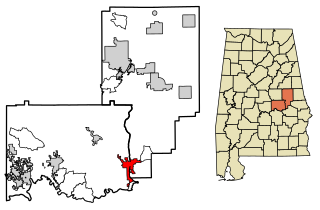
Tallassee is a city on the Tallapoosa River, located in both Elmore and Tallapoosa counties in the U.S. state of Alabama. At the 2010 census the population was 4,819. It is home to a major hydroelectric power plant at Thurlow Dam operated by Alabama Power Company.

The Little Tennessee River is a 135-mile (217 km) tributary of the Tennessee River that flows through the Blue Ridge Mountains from Georgia, into North Carolina, and then into Tennessee, in the southeastern United States. It drains portions of three national forests— Chattahoochee, Nantahala, and Cherokee— and provides the southwestern boundary of the Great Smoky Mountains National Park.

Birkett Davenport Fry was an adventurer, soldier, lawyer, cotton manufacturer, and a Confederate brigadier general in the American Civil War. A survivor of four battle wounds, he commanded one of the lead brigades during Pickett's Charge at the Battle of Gettysburg.

WTLS is a radio station in Central Alabama, 30 miles northeast of Montgomery. The station broadcasts 24 hours a day. WTLS streams programming over the internet through its website.

Overhill Cherokee was the term for the Cherokee people located in their historic settlements in what is now the U.S. state of Tennessee in the Southeastern United States, on the western side of the Appalachian Mountains. This name was used by 18th-century European traders and explorers from British colonies along the Atlantic coast, as they had to cross the mountains to reach these settlements.

Chilhowee was a prehistoric and historic Native American site in present-day Blount and Monroe counties in Tennessee, in what were the Southeastern Woodlands. Although now submerged by the Chilhowee Lake impoundment of the Little Tennessee River, the Chilhowee site was home to a substantial 18th-century Overhill Cherokee town. It may have been the site of the older Creek village "Chalahume" visited by Spanish explorer Juan Pardo in 1567. The Cherokee later pushed the Muscogee Creek out of this area.

Tallassee is a prehistoric and historic Native American site in present-day Blount and Monroe counties, Tennessee in the southeastern United States. Tallassee was the southernmost of a string of Overhill Cherokee towns that existed along the lower Little Tennessee River on the west side of the Appalachian Mountains in the 18th century. Although Tallassee receives scant attention in primary historical accounts, it is one of the few Overhill towns to be shown on every major 18th-century map of the Little Tennessee Valley.
Talisi is an alternate spelling of Tallassee, which may refer to:

Kodak is an unincorporated community and a neighborhood of Sevierville in Sevier County, Tennessee, United States. It is located along State Highway 139 and State Highway 66, and just south of I-40 and Knoxville, Tennessee. The elevation of Kodak is about 896 feet above sea level.
U.S. Route 129 is a north–south United States highway that runs for 52.8 miles (85.0 km) in East Tennessee, from the North Carolina state line, near Tapoco, to Knoxville. In Tennessee, the highway is completely overlapped by unsigned State Route 115.
Callaways Little Island, or Kirkland Island, is a small island 1.4 miles WSW of Tallassee, Tennessee within the Chilhowee Shoals of the Little Tennessee River, Monroe County, Tennessee.
The Georgia–Alabama League was a minor league baseball league that operated in its two namesake states. The circuit first operated from 1913 to 1917, was revived from 1928 to 1930, then returned to operation for a final time from 1946 through 1951. The league's existence thus spanned some 39 years, but it only fielded teams in 14 seasons. All versions of the Georgia–Alabama League were Class D leagues, the lowest classification in Organized Ball during their years of operation.

Tallassee Airport is a closed airport located 4 miles south of Tallassee, Alabama, United States.

Tallassee is an unincorporated community in Blount County, Tennessee, United States. Its ZIP code is 37878.

Tapoco is an unincorporated community in Graham County, North Carolina, United States. Tapoco is located on U.S. Route 129 near the Little Tennessee River, 11 miles (18 km) northwest of Robbinsville. Named for the acronym of the former Tallassee Power Company, Tapoco had a post office until it closed on October 26, 1995.
State Route 72 is a 43.3-mile-long (69.7 km) state highway in the eastern portion of U.S. state of Tennessee. It travels through the towns of Vonore and Loudon.
The Tallassee Tribune is a weekly newspaper serving Tallassee, Alabama and surrounding Elmore County. It is currently owned by Tallapoosa Publishers Inc.
Derrick Ansley is an American football coach and former player. He is currently defensive backs coach for the Los Angeles Chargers. He was previously the defensive coordinator at Tennessee. He played safety at Troy from 2001-2004 before starting his coaching career at Huntingdon, a Division-III school in 2005.

The historic Cherokee settlements were Cherokee settlements established in Southeastern North America up to the removals of the early 19th century. Several settlements existed prior to—and were initially contacted by—explorers and colonists of the colonial powers as they made inroads into frontier areas. Others were established later.











